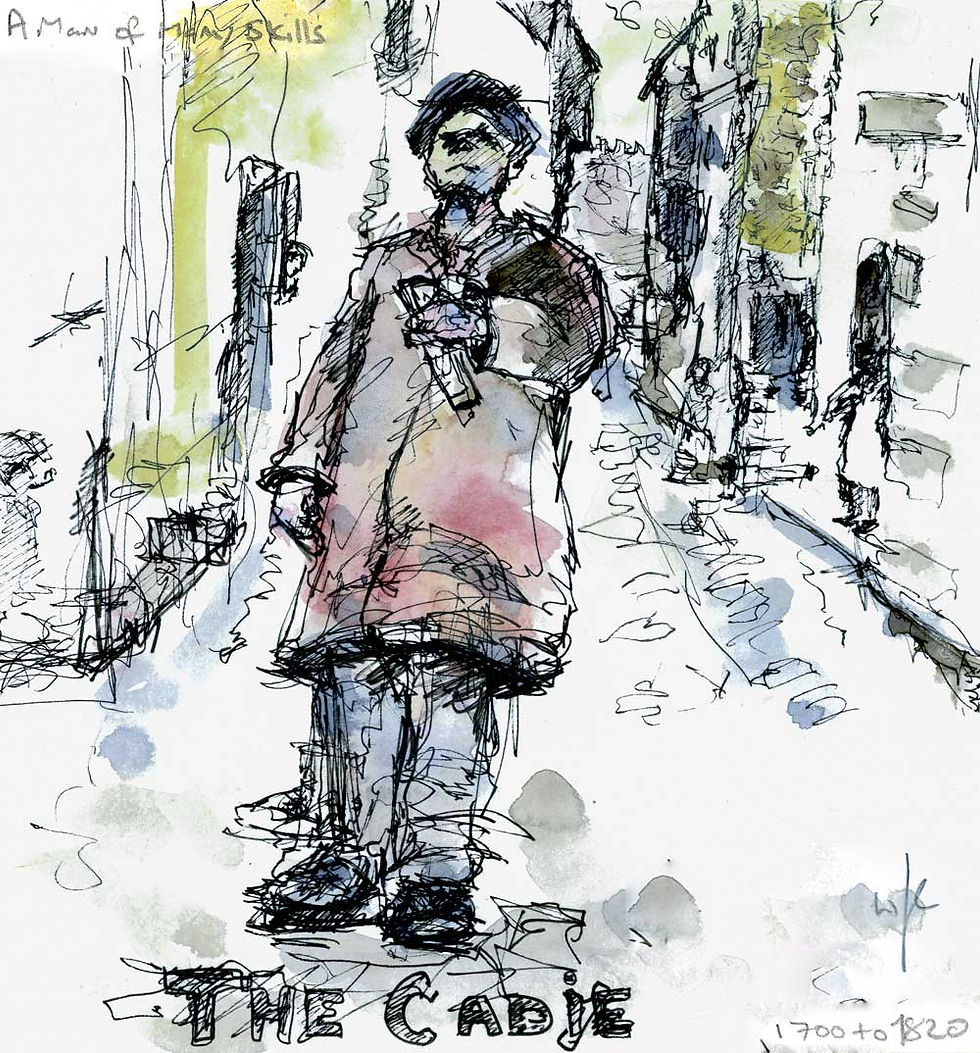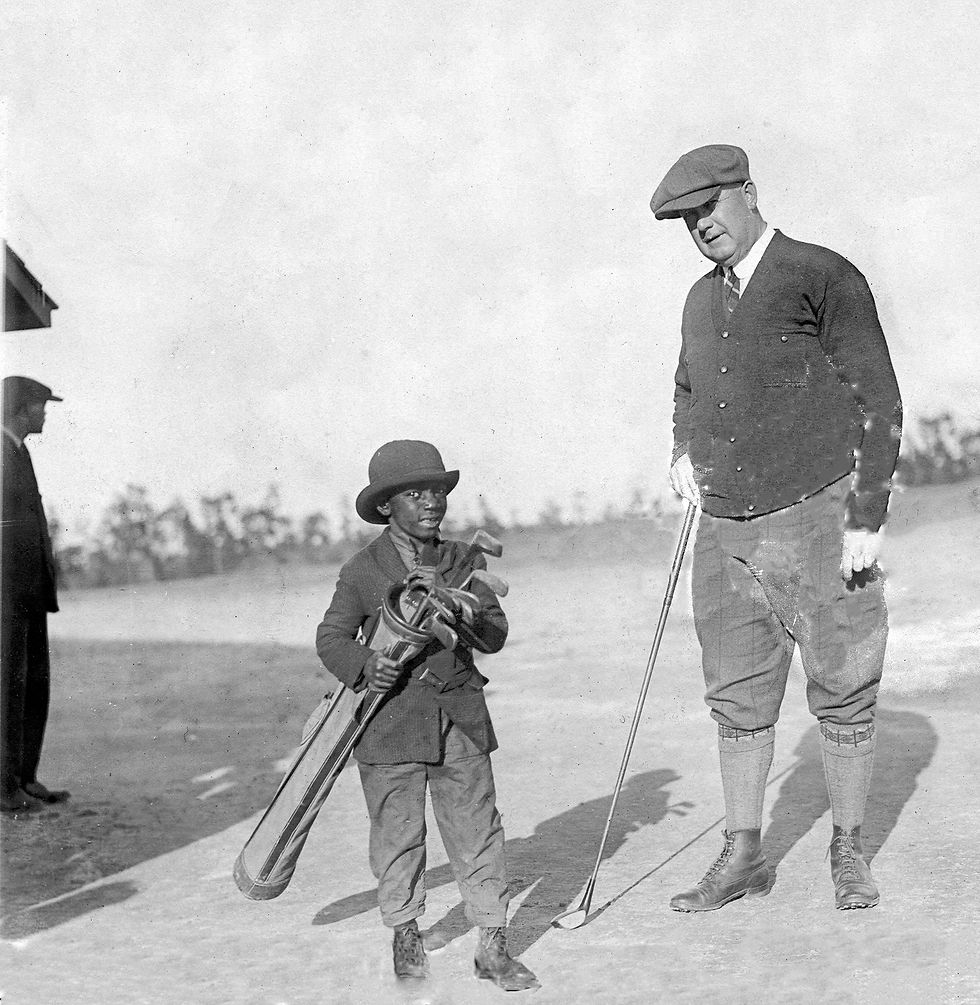Caddy and Master-a team
- Bill Knowles
- Jul 25, 2022
- 6 min read
Updated: Dec 6, 2023
"Bones did an unbelievable job of just keeping me in the moment. We just tried to play the golf course for what it is."-Justin Thomas.


"Bones [Justin Thomas's Caddie] did an unbelievable job of just keeping me in the moment. We just tried to play the golf course for what it is."-
Justin Thomas after winning the PGA Championship this year.
It`s a great example of how the modern tour caddy goes far beyond just carrying the bag for his player. Each fulfills a role that helps his player to be successful for the week. It may be a very active partnership with constant discussion, with the caddy even acting as a therapist and motivational coach. Or a more subtle balance, where the caddy leaves his player in peace and just ensures he is comfortable and has everything at hand.
Some Caddy stories using art, photography, and film.
Two great caddies and the Caddy Hall of Fame
Peter Coleman

One of the longest caddy/player partnerships in Tour golf history-Peter Coleman and Bernard Langer. Peter Coleman has been caddy to many(including Seve Ballesteros) but will be remembered for his association with Bernard Langer.
Experience will make the task easier for the player. Routine and discipline, quiet concentration, an economy of words.
The caddy quietly fulfills his role and supports the Master under the intense atmosphere of the playing arena.

Caddy Hall of Famer Alfred `Rabbit` Dyer.

`Rabbit` Dyer caddied for Ben Hogan, Arnold Palmer, Dave Stockton, and Lee Trevino before being hired by Gary Player in 1972.
The caddy hall of fame
In 1999 a caddy hall of fame was created by the Professional Caddy Association

The Caddie Hall of Fame highlights the tradition and importance of caddying by recognizing and celebrating individuals who have devoted their lives to the game of golf through caddying or by supporting the role of caddies, or who have used their experiences as a youth caddie as a stepping stone for success.
Founded by Dennis and Laura Cone.
The caddy history goes back 350 years One of the earliest documentation and descriptions of the first "Cadie`s" can be found in the early letters and accounts of G.Topham. Topham was a captain in the army who wrote many letters about Edinburgh life in the 18th century.

The caddie(spelled cadie at the time), according to Topham was of huge benefit to the lives of the town inhabitants and all of those who visited. He was a man of all trades who was educated in nearly every aspect of importance. Able to repair a broken gate or provide assistance to any business that required a short help, and all for a nominal fee. They also knew every individual in the city and could direct you to any address you wanted to find(no mean feat in a tight urban area where the houses mostly consisted of several floors with a multitude of families dwelling within).

The first named golf caddie was Andrew Dickson, who would later become a golf club maker. His name is first documented while fulfilling his role as fore-caddie for the Duke of York in the famous Duke's golf match of 1681 played on Leith Links near Edinburgh. At this time the forecaddie was seen as being of the lowest importance in the caddy ranks, although they reduced the cash weight of their master's need to buy very expensive feathery balls. It takes little imagination to work out where the shout of fore originated from.

Old Fiery, whose real name was John Carey was so-called because of his ruddy face.
He was one of the most famous caddies in the early history of golf and was, what could be described as a professional caddie. Willie Park Junior never played in an important match, home or away, without his famous caddie.
Unlike many caddies of the day, he was well-spoken and well-mannered. Fiery was in great demand and caddied for many of the distinguished amateurs and professionals of his time.

The early golf bags started to appear at the end of the 19th century. Until then all clubs were held under the arm of the caddy and held together with string or old boot laces. The first examples were not much different from the modern pencil bags that we use today. The illustration shows that only a decade down the road things were getting more elaborate.
The fishing trade in Scotland was the source of many caddies who preferred the less dangerous and harsh leanings of the sea. It marked the beginnings of the famous St. Andrews caddies(who still exist today).

Apart from cleaning and carrying clubs, many were also adept at providing `extra` services to ensure an enjoyable round. There are countless humorous stories about Caddy's exploits and the characters who performed them. Some collected specialist names in accordance with their skills.
An example would be `Hole`s in Pocket` who was well known for dropping a ball out of his pants, no such thing as a bad lie after all, when you used his services.
Although it is impossible to check how many of the Gentlemen golfers were aware of this activity it has been mentioned that three pennies would cover most `extras`.




In the 1920s a few books on how to develop good caddies appeared. The best of those was a 140-page booklet that was circulated in the Kansas area. It was hoped that the caddies would be taken more seriously and treated with equal fairness in every golf club.

The book was written by Frank Lauder, who covered every detail possible. It made three editions and was used by most clubs in the area at this time.
The history of golf has also seen many great players emerging from the caddy ranks.

Of the many hundreds of caddies to achieve tour professional status, the two most famous were undoubtedly Byron Nelson and Ben Hogan, who remained intertwined with each other throughout both of their stellar careers.
Both Hogan and Nelson were born in 1912, both began their caddy beginnings within months of each other and continued to follow a near-identical path throughout the four to five years of working at the Glengarden club.
Eventually, both would join the professional ranks at the same time and go on to win majors.
A less happy story.

Unfortunately, and particularly in the African/American community, not all those with tour skills managed to get their talents recognized.

Possibly the most famous former black caddie is Charlie Sifford. He managed to finally break the resistance of the USPGA and its Caucasian rule in 1961 and gain a license to compete on the tour. For the whole story click link

Caddies from around the world.
The many photos of caddies from around the world and throughout 150 years of golf history tell so many wonderful stories.
For an original caddy etching series click the link
Pinehurst and Taylor Town.
Taylor town, although now having only a few resident caddies, survives to this day.
In 1938, a writer described Taylortown - founded in 1895 for black people by former slave Demus Taylor - as ``Caddytown.' The 500 or so men and boys who caddied the courses at Pinehurst then came from Taylortown and another nearby black community, Jackson Heights.
Today only about 85 caddies remain to work on Pinehurst's eight golf courses, and half of them are white.
Residents of the Town are not as dependent on Pinehurst anymore and today are more likely to become doctors or lawyers.
In the early days the pay was good and the workday short.
Afterward, the men had plenty of time to drink and play cards.

Unfortunately, when many of these men grew old and couldn't walk the courses anymore, they became alcoholics. They were without Social Security benefits having not paid any taxes on the cash they had received from golfers. Many died in wretched poverty.
One of the more well-known caddies of the early times was James Steed.
Known for his blunt way of addressing the rich white golfers whose bags he carried. In a 1976 interview, he recalled how disappointed he was when he was first assigned to caddy for Sam Snead in a tournament in the 1930s. Snead was just starting as a pro. Steed wanted a well-known pro.
``I ain't never heard of you,' he told Snead. After watching Snead for a few holes, however, Steed knew he had found a winner.

In the 1950s the first golf carts began to appear on the courses and would inevitably lead to reduced numbers in the caddy ranks

With the money earned by selling land needed for the Pinehurst golf course, Demus Taylor and his son, school teacher Robert Taylor bought land from the Town. They were part of the community that helped build the resort and kept it going, supplying servants, caddies, and laborers needed for the hotels and golf courses.
Taylor was born in 1826 and at one time was the property of the brother of President Zachary Taylor. When freedom came after the Civil War, Taylor prospered. At 6 feet 4 inches tall, he could chop down 100 trees a day.
Taylor lived to the age of 108 and became the wealthiest man in the town.
The old shacks that housed many in Taylortown - visible in photos in the Tufts Archives - are now gone. The houses today are modest and mostly well-kept. The biggest house is the one Demus Taylor built many years ago.


Caddy facts-Today a caddie on the tour circuit usually gets a guaranteed minimum ($20,000–$30,000/yr.) and is included in a percent of a golfer's winnings, up to 10%.
The sums the more prominent bag carriers are paid per annum can be 200 thousand dollars, with the ceiling going to over a half million! Although the sums can be high every caddy knows he is easily dispensable.
A caddy is also expected to pay their expenses and will have to make his or her arrangements to get to the events.















Gary Player must have paid well...Alfred Dyer (from my hometown of New Orleans...) earned enough to put one of his sons through Princeton.He even caddied for Frank Sinatra and Evel Knievel. Everything I've heard about him indicates he had a heart of gold.